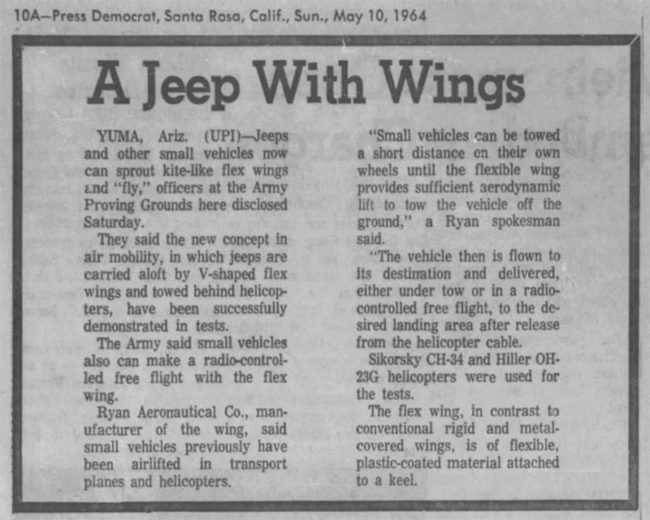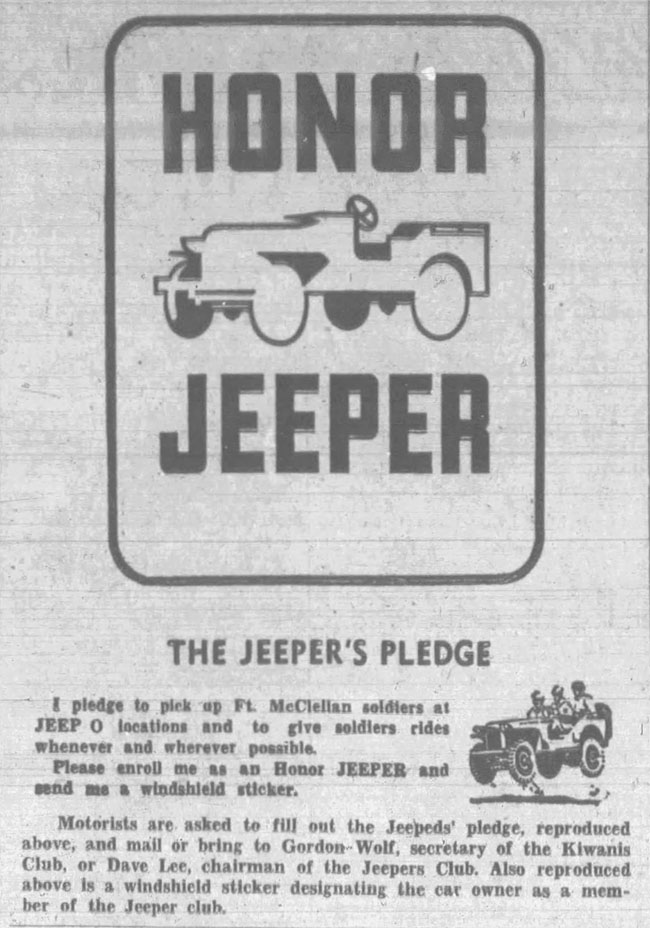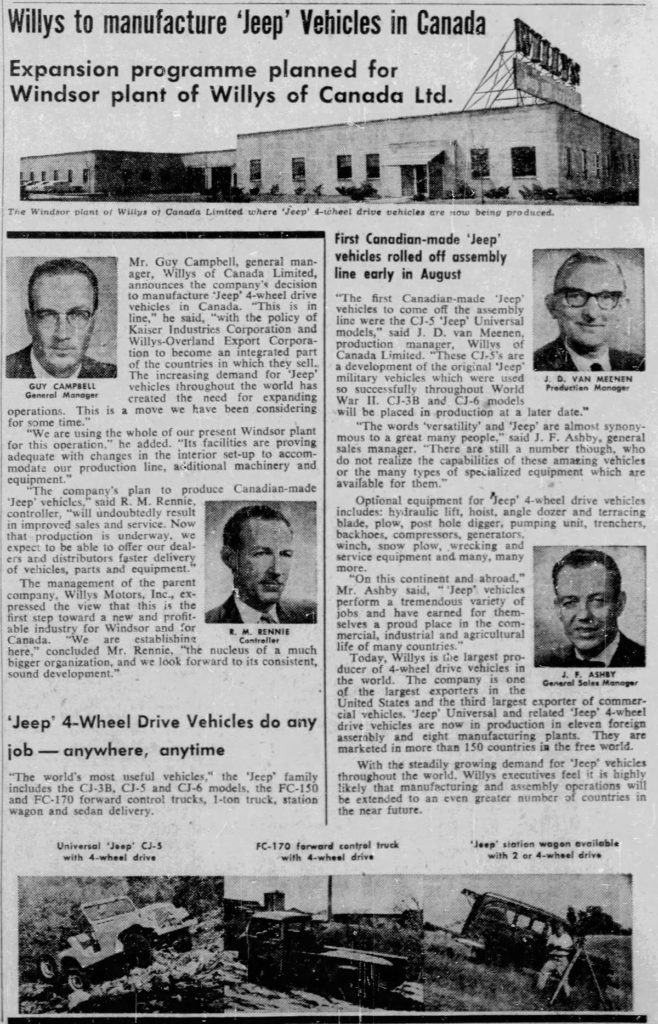This in-depth article on the use of jeeps and planes includes a variety of photos. It appeared in the April 08, 1951, issue of the Nevada State Journal.
This in-depth article on the use of jeeps and planes includes a variety of photos. It appeared in the April 08, 1951, issue of the Nevada State Journal.
This article in the October 22, 1944, issue of the Miami Herald explains how, during a hurricane-related power outage, an Army jeep was used to power a printing press, saving the news day.
This photo and caption shares Carol McDonald’s demonstration of how to hang off a jeep as a counterbalance during the middle of a jeep race.
In 1949, Mr. and Mrs. William H. Meyer drove in a CJ-2A from the Panama Canal to Decatur, Illinois. The article below provide the only records I could find related to their trip. This first article summarizes the adventure and shows a great photo of “DOPEY”. It was published in the Decatur Review, June 16, 1949:
This second article is a pictorial of the trip that was published June 18, 1949, in Bloomington, Illinois’ “The Pantagraph”:
This is a different summary of the trip, but contains no photos. It was published in the Daily Advertiser (Lafayette, Louisiana) on May 13, 1949:
This last article was published June 17, 1949, in the Herald and Review out of Decatur, Illinois:
This October 21, 1969, article from the Daily News-Post (Monrovia, California) included some great photos. It’s quite a spread! The review of the unit was very positive, almost a little too positive.
A March 06, 1949, photo in the Pittsburgh Sun-Telegraph highlighted Newgren’s recently introduced bush and bog harrow. The Pittsburgh firm of Buyers Motors was promoting this piece of equipment and others as part of a product exhibition for Willys-Overland Motors dealers.
As part of the development of this uniquely styled rear-engine car, in 1937 Basil (Barney) Oldfield built a prototype he called the “Jeep”. The “Jeep” sold him on the idea of a rear engine vehicle, so he began development of a safer, more dependable vehicle built around the rear engine. Unlike Tucker’s rear-engine auto design, Barney’s “Spirit of Tomorrow”, completed in 1942, did not lead to a manufactured product. But, Barney did achieve his goals, as Ralph Nader approved of his vehicle, claiming it was roomier, safer, and had more visibility.
This September 05, 1967, article form the Victoria Colonist (Victoria, B.C.,) provides some good early history on the vehicle.
The “Spirit of Tomorrow” still runs. This 2018 video interview provides additional information:
https://www.sookenewsmirror.com/community/spirit-of-tomorrow-car-still-turning-heads-after-76-years/
These pics featuring the newly designed jeep appeared in the December 05, 1941, issue of the Ithaca Journal, two days before Pearl Harbor. I feel bad for those women having work the line in a dress and high heels.
The blurb below states:
THE JEEP TAKES ITS PLACE IN ARMY AND IN DICTIONARY: Officially designated as “quarter-ton four-by-four trucks,” but known to the U.S. Army as jeeps, the fast little scout cars, being turned out by thousands to serve as liaison between advanced mechanized units and infantry follow-ups, now are recognized as among the most important contributions of modern American assembly-line methods to the service. Powered with a 63-horsepower, four-cylinder engines, the jeep has a four-wheel drive, can carry three men and a machine gun, and can tow a heavy-calibre anti-tank gun. The pictures, illustration jeep production and testing, were made at the Willys-Overland plant in Toledo, Ohio. Left (in our case top): Women employees at work on a jeep assembly line. In the rear is an assembly line of civilian cars. Center: The cars being tested on the proving-ground. At right (in our case at the bottom): Negotiating an open field choke with heavy brush.
This Northwestern Auto Parts and Wilenskey Auto parts ads in the January 05, 1947, issue of the Star Tribune out of Minneapolis highlighted engine kits that allowed a jeep engine and transmission (which was included with the purchase), along with the necessary mountings, to be installed into certain Ford, Plymouth, and Chevrolet vehicles. I wasn’t aware there were kits design to do this.
This July 8th, 1943, article in the Oakland Tribune shares information and pics on the Ford assembly plant in Richmond, California. Note the rationing table at the top of the page.
This April 21, 1943, ad in the Victoria Advocate (Victoria, Texas) encourages kids to join a jeep club designed to raise money through war bond sales. It includes an illustration of a Ford GP.
This March 23, 1943, article on the “Seagoing Jeep” was published in the Fort Worth Star Telegram Evening edition.
This April 03, 1946, photo from the Spokesman Review shows Dave Zimmerman and his band/radio show ensemble stuffed into a jeep. With a Detroit transit strike raging, a borrowed jeep was the only way to get everyone to their radio show gig.
According to this page, Dave Zimmerman was a long time announcer at WWJ in Detroit. He hosted a popular radio program called Coffee Club and was on the air for Detroit’s first television broadcast from the 47th floor of the Penobscot Building.
In May of 1964 newspapers across the country shared the news of the Army testing out an idea where v-shaped flexible wings were attached to vehicles such as jeeps, allowing them to be pulled behind aircraft and flying to their destinations.
I tried to find photos of the jeeps with V-wings, but I had no luck. There is this example of the Army testing the v-wing concept they called a “Fleep”, which may use a similar flexible v-wing.
Ryan RV-8 Fleep Final Report 1964 US Army; Rogallo Wing Aircraft from Jeff Quitney on Vimeo.
This first article appeared in the May 10, 1964, issue of the Press Democrat out of Santa Rosa, California: 
This second article was published in the May 12, 1964, issue of the South Bend Tribune, out of South Bend, Indiana:
In 1946 the wiz kids at the University of Rochester, NY, and Eastman Kodak built the world’s largest radiograph, one that could create an X-Ray photo of a large machine, say a jeep, which is precisely how they tested it. In the jeep’s case, the team used the million-volt x-ray machine to create a radiograph 12′ 1″ long by 4′ 1″ tall, or large enough to contain a life size jeep. The larger goal was create the ability to X-Ray large machinery.
The February 8th, 1946, issue of Rochester Democrat Chronicle shared the story:
The next month, Life Magazine also ran the story, this time with a copy of the X-ray photo (seen at top):
This unusual ad appeared in the December 18, 1945, issue of the Poughkeepsie Journal. I guess marketers figured adding the “jeep” name to most anything was a good bet for increasing sales?

This pledge for Jeep-O club drivers was published in the July 07, 1943, issue of the Leaf Chronicle out of Clarksville, Tennessee. This pledge appears to have been unique to the Clarksville area.
In April of 1943, the Kiawanis Club of Anniston, Alabama, started the Jeep-O Club, an effort to alleviate the transportation problem facing soldiers by pledging to give rides in their vehicles to soldiers who needed one. It was an early Uber system, only with volunteer drivers.
It’s possible the Kiwanis Jeep-O movement got is name from the previous November’s Jeep-O gram movement in Texas.
This photo shows an actual Jeep-O stop. It appeared in the April 15, 1943, issue of the Huntsville Times:
By May, the Jeep-O club idea had already spread to 22 states:
A couple months later, in the July 07, 1943, issue of the Leaf Chronicle out of Clarksville, Tennessee, the paper reported how a Jeep-O club was staring up there: Continue reading
This full page article with photos shows a group that called themselves the “Jeepological Survey” exploring the Panamint Range Canyons. This was published in the November 13, 1953, issue of the Valley Times out of San Fernando, California.
This March 24, 1955, article from the Santa Cruz Sentinel shows Boys Scouts readying a jeep display to demonstrate both traffic safety and jeep camping.
Columnist Russ Leadabrand thinks the jeep is the best way to see California. This column appeared in the June 29, 1960, issue of the Pasadena Independent:
This “Figment to Face” article about the jeep’s conception-to-reality story landed in a variety of newspapers across the US, though this is the best scan of it so far (which doesn’t speak too highly of the other scans, as it shouldn’t). I wondered how many other drawings were made that weren’t realized with the standardization of the jeep.
The article appeared in the Daily Reporter out of Greenfield, Indiana, on October 19, 1942:
UPDATE: Here’s an example of a Windsor, Canada, data plate, one of the CJ-5s that was imported from Canada to keep up with sales demand in the US.
===================
On August 21, 1959, the first Canadian-built jeep, a CJ-5, rolled out of the assembly plant in Windsor, Canada. Below are two articles and one advertisement that celebrates the acheivement.
This first article appeared August 22, 1959, in the Windsor Star and shows the actual first CJ-5.
 This second article appeared September 19, 1959, in the National Post our to Torono, Ontario, Canada, and shows the actual Windsor Plant.
This second article appeared September 19, 1959, in the National Post our to Torono, Ontario, Canada, and shows the actual Windsor Plant.

This third item is an advertisement that appeared in the August 25, 1959, issue of The Province, a Vancouver newspaper.
This press photo appeared in multiple newspapers, including the July 20, 1950, edition of the Austin Statesman.
View all the information on ebay
“AMERICAN SOLDIERS In JEEP w .50 CAL MACHINE GUN In KOREA 1950 Press Photo. Size is approximately 7×9 to 8×10 inches. If significantly smaller or larger the specific size will be accurately described.”
Here’s the newspaper clipping:
While searching for this press photo I also spotted this photo of a unique gun mount. It was published in the August 04, 1950, issue of the Arizona Republic:
This was something new to me. Some war bond buyers were allowed to sign scrolls that would then be loaded on bombers and dropped over Axis-controlled countries. This photo and caption appeared in the May 20, 1943, issue of the Star Tribune out of Minneapolis.